Investigation of the interaction between NS-DBD plasma-induced vortexes and separated flow over a swept wing
Bei LIU(劉備),Hua LIANG(梁華) and Borui ZHENG(鄭博睿)
1 Science and Technology on Plasma Dynamics Laboratory,Air Force Engineering University,Xi’an 710038,People’s Republic of China
2 The Green Aerotechnics research Institute of Chongqing Jiaotong University,Chongqing 401120,People’s Republic of China
Abstract The effect of nanosecond pulsed dielectric barrier discharge(NS-DBD)plasma flow separation control is closely related to the actuation frequency,because it involves the interaction between plasma-induced vortexes and separated flow.In order to study the mechanism of NS-DBD plasma flow separation control over a swept wing,especially the influence of the actuation frequency,at first,experimental studies of the actuation frequencies at 100 Hz are conducted to validate the numerical simulation method.Then,numerical studies of different actuation frequencies which are 50 Hz,100 Hz,160 Hz,200 Hz,500 Hz,and 1000 Hz,respectively are conducted.The interaction between the plasma-induced vortexes and the separated flow is analyzed.Results show that there is a range of the actuation frequency which includes the frequency(160 Hz)calculated by the average aerodynamic chord length to make the control effect good,but when the actuation frequencies are too low(50 Hz)or too high(1000 Hz),the control effect will get worse.The former is because plasmainduced vortexes disappear in a period within an actuation cycle;the latter is because plasma-induced vortexes cannot develop completely,resulting in a weak vortex intensity.
Keywords:plasma-induced vortex,flow separation control,NS-DBD,LES
1.Introduction
Nanosecond pulsed dielectric barrier discharge(NS-DBD)and alternative current dielectric barrier discharge(ACDBD)are two main plasma flow separation control methods.Because of the higher actuation frequency and intensity of NS-DBD in contrast with AC-DBD,the control effect of NS-DBD is better than that of AC-DBD[1,2].Studies show that when the flow Mach number is 0.4,AC-DBD almost has no control effect[3]while even though the flow Mach number reaches 0.74,NS-DBD also has a good control effect on flow separation[4].NS-DBD is even used to control the strong shock wave ahead of a circular cylinder in which the flow Mach number is 5[5].
The mechanism of AC-DBD plasma actuation for flow control is momentum effects due to ionic wind created by the discharge,which can accelerate the flow in the boundary layer.Therefore,the ability of the flow to resist adverse pressure gradient becomes stronger.Experimental studies show that the ionic wind can only reach to several meters per second(less than 10 m s?1)discharging in quiescent air[6],so the control effect of AC-DBD is limited.Whereas,the mechanism of NS-DBD plasma actuation for flow control is transient heat effects which induce shock waves and starting vortexes that interact with the separated flow[7,8],resulting in the flow separation being controlled.Experimental studies show that the induced flow velocity of NS-DBD is less than 1 m s?1[9].
For both AC-DBD and NS-DBD,the effects on flow separation control are closely related to the actuation frequency.Audieret alstudied a post-stall flow over NACA0012 airfoil by AC-DBD experimentally[10].Results show that the higher the actuation frequency,the better the control effect,and the closer to the control effect of steady actuation.Abdollahzadehet alvalidated the conclusion by a numerical study which is also about the flow separation control of NACA0012 airfoil by AC-DBD[11].Sidorenkoet alstudied the control effect of NS-DBD on an airfoil by experimental method.Results show that the optimum actuation frequency depends on the angle of attack and flow velocity[12].Niuet alconducted an experimental study on flow separation control of a flying wing by NS-DBD when theRenumber is 2.61×106and Mach number is 0.2.Results show that the actuation frequency of 100 Hz is better than those of 200 and 300 Hz[13].
Obviously,for the flow separation control of NS-DBD,it is not the case that the higher the actuation frequency,the better the control effect.The actuation frequency is generally dimensionless as follows:
wherefis the actuation frequency,U∞is the flow velocity,cis the reference length.It is believed that the control effect is best whenF+=1in 2D cases for NS-DBD and the reference length is the chord length of the airfoil[14].But for 3D cases such as a swept wing,how to take the reference length is a problem,especially for the wing with a large root-tip ratio.In order to investigate the interaction between NS-DBD plasma-induced vortexes and separated flow over a swept wing,a numerical study with high precision is essential because more flow field details can be obtained than an experimental study.But most of the numerical studies are conducted over an airfoil,few are over a swept wing due to large computation consumption.
There is an optimum actuation frequency for NS-DBD plasma flow control,but the control mechanism is still not clear,especially for a swept wing(there is no definite reference length).The mechanism of NS-DBD plasma flow control is mainly about the interaction between plasma-induced vortexes and separated flow,but the interaction process is also not clear.In this study,in order to investigate the interaction mechanism,large eddy simulation(LES)method is adopted to simulate the flow over a swept wing.Owning to the higher accuracy than Reynolds Averaged Navier–Stokes and less computation than direct numerical simulation(DNS),LES method has been extensively used in the flow simulation with large separation[15–17].Although the computation of delayed detached eddy simulation(DDES)is less than LES,considering more turbulence dissipation which could affect the investigation of the vortex interaction,the DDES method is not adopted.
The rest of this article is organized as follows:section 2 is the experimental study of plasma flow separation control;section 3 validates the LES method according to the experimental data;section 4 shows the numerical study of plasma flow separation control;section 5 is for conclusions.
2.Experimental study
The experimental model is made of aluminum alloy and the surface is very smooth,see figure 1(a).The plane size is shown in figure 1(b).The sweep angle is 20 degree and the lengths of wing root,wing tip,leading edge,and tailing edge are 0.903 m,0.15 m,1.15 m,and 1.104 m,respectively.The length of average aerodynamic chord length is 0.527 m.The relative thickness from the wing root section to the wing tip section varies uniformly from 6.8% to 5.6%.The five cross sections which are at 0%,25%,50%,75%,100% spanwise positions respectively are shown in figure 1(c).
The experiment is conducted in a low-speed acoustic wind tunnel in which there is a 139.0512.5 m3××silencing section to reduce the noise and the turbulence.The section size of the wind tunnel test part is21.5 m2,×and the maximum test wind speed is 110 m s?1(0.32 Mach).The wind speed required for the experiment is 0.25 Mach.The model in the wing with and without plasma actuation is shown in figure 2.Anode and cathode materials are attached to the leading edge of the wing which has been proved to be the best position[18](see figure 2(b)).A cross section of the installed wing with plasma actuation is shown in figure 2(c).The thicknesses of the anode and cathode are both 0.1 mm and the thickness of the electrolyte is 0.18 mm.The lengths of the anode and cathode are 3 mm and 5 mm,respectively and the distance between them is 0 mm.
In the experiment,high voltage pulses are generated by a nanosecond pulse generator(HVP-20),the applied voltage and the discharge current are measured by a voltage probe(Tektronix P6015A)and a current probe(Tektronix TCP312+TCPA300),respectively and the signals are recorded on an oscilloscope(Tektronix DPO4104).A single pulse waveform which is used in this experiment is shown in figure 3.The applied voltage is 8 kV and the full width half maximum is 300 ns.The experimental velocity is 85 m s?1(0.25 Mach),the pressure is 1 atm,the temperature is 290 K and the turbulent intensity at the wing tunnel inlet is 0.16%.The Reynold number is calculated based on unit length(1 m).According to the principle that the optimal actuation frequency meetsF+=1,if taking the wing root length as the reference length,it will be 94 Hz;if taking the wing tip length,it will be 567 Hz;if taking the average aerodynamic chord length,it will be 161 Hz.The higher the actuation frequency,the larger the energy,the easier it is to break through the plasma actuator,resulting in leakage.Because the whole experimental system is very expensive and the experimental model is mental,for the sake of safety,only the actuation frequency of 100 Hz is conducted.(When taking the wing root length as the reference length,the optimal actuation frequency is 94 Hz.)In addition,this problem is mainly investigated by numerical simulation,the small amount of experimental data is used to validate the numerical method.The energy of the single pulse in figure 3 is 79.08 mJ and it is calculated by the following formula:
The length of the actuator is 1.15 m,so the energy per unit length of the pulse is 0.688 mJ cm?1which is within the scope given by Takashimaet al[8].If the actuation frequency is 100 Hz,the output power will be 7.908 W;if the actuation frequency is 1000 Hz,the output power will be 79.08 W.
The experimental results are shown in figure 4.When the actuation voltage is 8 kV and the actuation frequency is 100 Hz,the maximum lift coefficient with the plasma actuation is 18.1% larger than that without the plasma actuation,and the stall angle of attack was delayed by 4°–5°.It indicates that NSDBD has a good effect on control flow separation.
3.LES method validation
Spatial resolution,temporal resolution and sub-grid model are the three critical factors that must be considered in the usage of LES[19].For the spatial resolution,as the computational mesh is successively refined,increasingly fine-scale turbulent structures are resolved,the computation eventually transitions to a DNS.For the temporal resolution,the time-step size needs to be able to describe the important physical phenomena.Obviously,smaller time steps are more desirable from an accuracy point of view,but also increase the resources required for the simulation.For the sub-grid model,the finest-scale fluid structures are not resolved in LES but equivalent by the sub-grid model and different subgrid models have different schemes and different accuracy.In the simulation,central difference scheme is adopted and SIMPLEC method is used for pressure–velocity coupling.The time step can be dimensionless as follows:
U∞is the flow velocity(85 m s?1),cis the reference length(0.15 m,wing tip length),tΔ is set as a constant of 0.00001 s in the base flow simulation,so dtis 0.0057.Sorensenet al[20]studied the influence of time steps on calculation.Results show that dt=0.01 is enough.In order to validate the grid and the sub-gird model,two sets of grids and two sub-grid models are selected.The total number of the coarse grid is 24 million and the fine grid is 68 million.They both meety-plus less than 1.Two sub-grid models are WMLES and WALE.WALE is a wall-solved model which has a high precision but with the increase ofRenumber,the computation increases rapidly.WMLES is a wall-modelling model which can greatly reduce the computation in the highRenumber condition.The angle of attack in the calculation is 18°.The contrast of aerodynamic force coefficients between the experiment and the simulation is shown in table 1(Clis the lift coefficient,Cdis the drag coefficient,ΔCland ΔCdare the contrast of the lift coefficient and the drag coefficient between the calculation and the experiment,respectively).The simulation with fine grid and WALE model agrees best with the experiment.
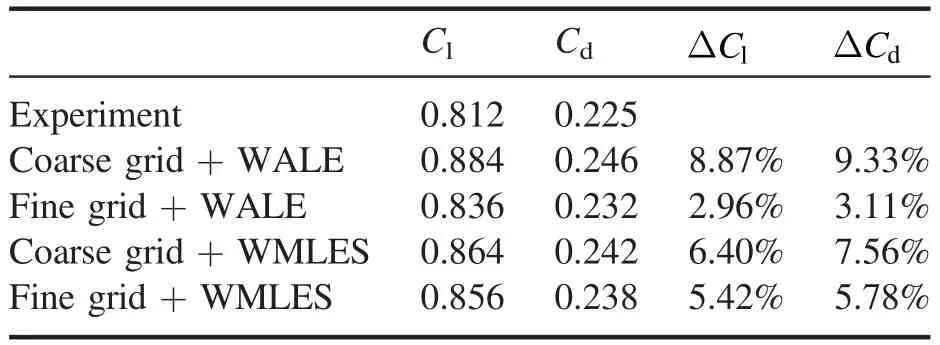
Table 1.Contrast of aerodynamic force coefficients between the experiment and the simulation when the angle of attack is 18°.
Figure 5 shows the vortex structures of the four simulation conditions when the time is at 0.6 s.It is obvious that the finer the grid is,the finer scale vortex structures can be caught and WALE model can catch finer scale vertex structures than WMLES model when the grid is same.So,the fine gird and WALE model are selected to conduct the numerical studies.
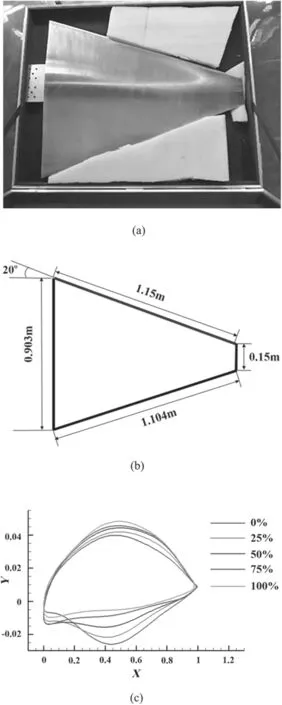
Figure 1.Experimental model(a),plane size(b),and five cross sections(c).
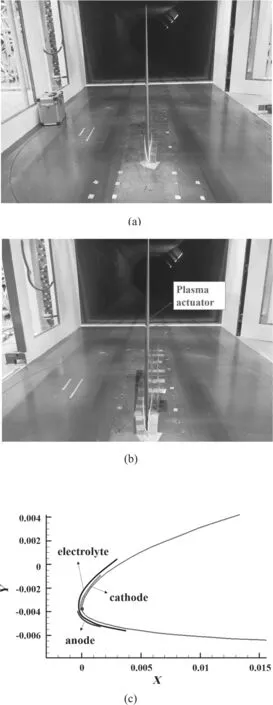
Figure 2.Experimental model without plasma actuator(a),with plasma actuator(b),a cross section of the model with plasma actuator(c).
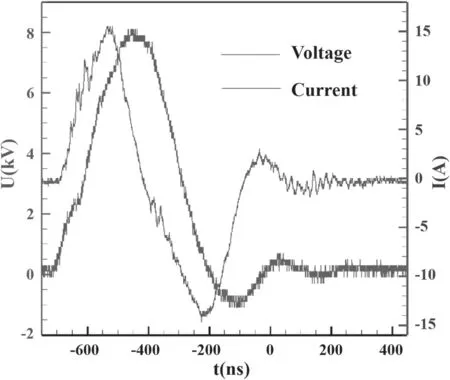
Figure 3.Voltage and current waveform of a single pulse.

Figure 4.Contrast of experimental results between with and without plasma actuation when the actuation frequency is 100 Hz and the actuation voltage is 8 kV(Ma=0.25, Re=5.74×106),lift coefficient(a),drag coefficient(b).

Figure 5.Vortex structures of the four simulation conditions when flow time is at 0.6 s(Q=10 000),fine gird+WALE(a),coarse grid+WALE(b),fine grid +WMLES(c),coarse gird +WMLES(d).
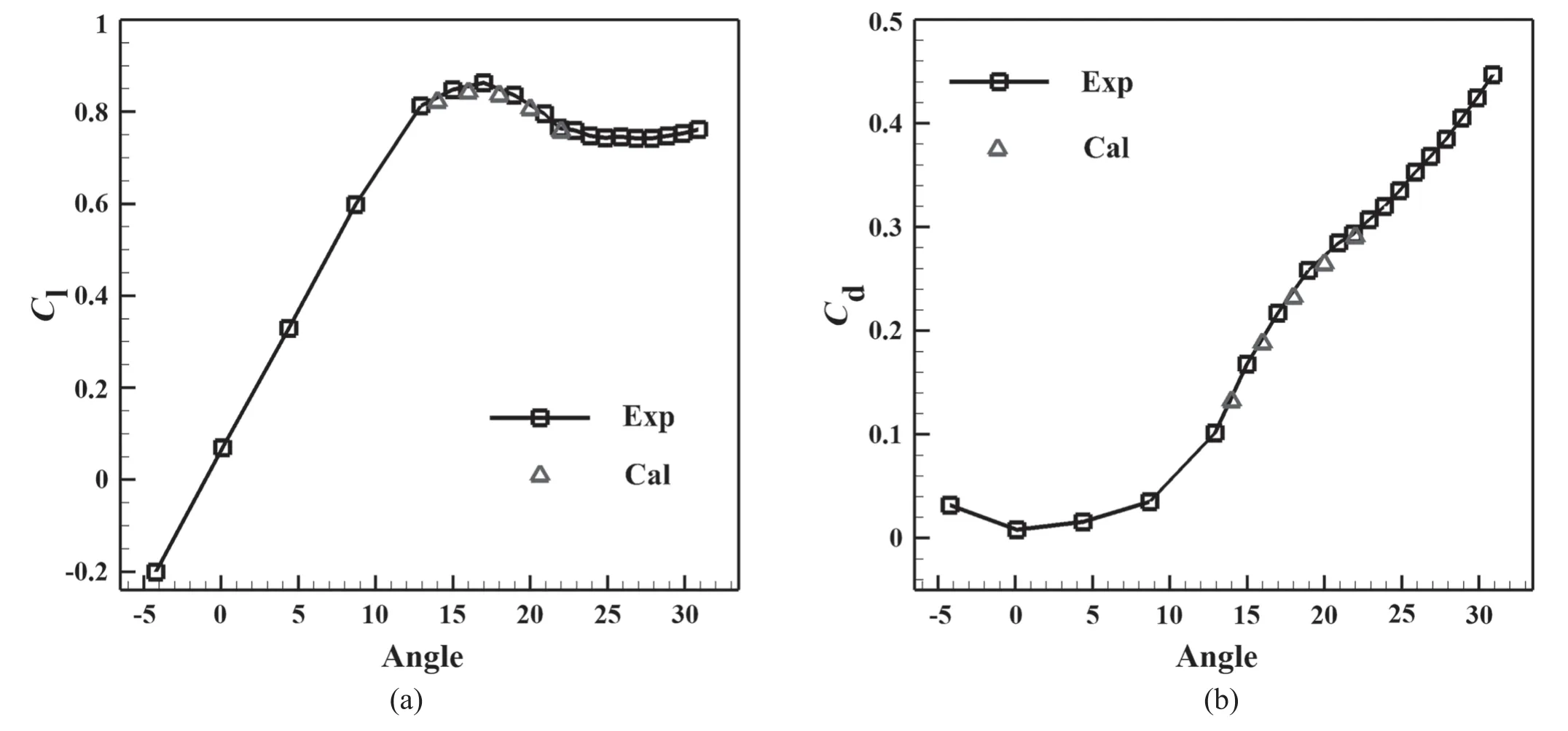
Figure 6.Contrast of aerodynamic force coefficients between the calculation and the experiment without the plasma actuation,lift coefficient(a),drag coefficient(b).
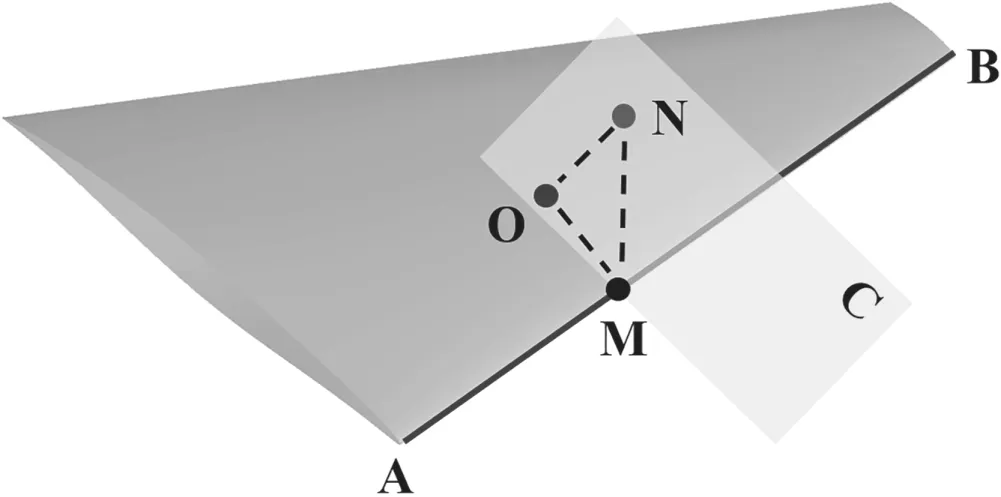
Figure 7.The determination process of x and y in formula(4).
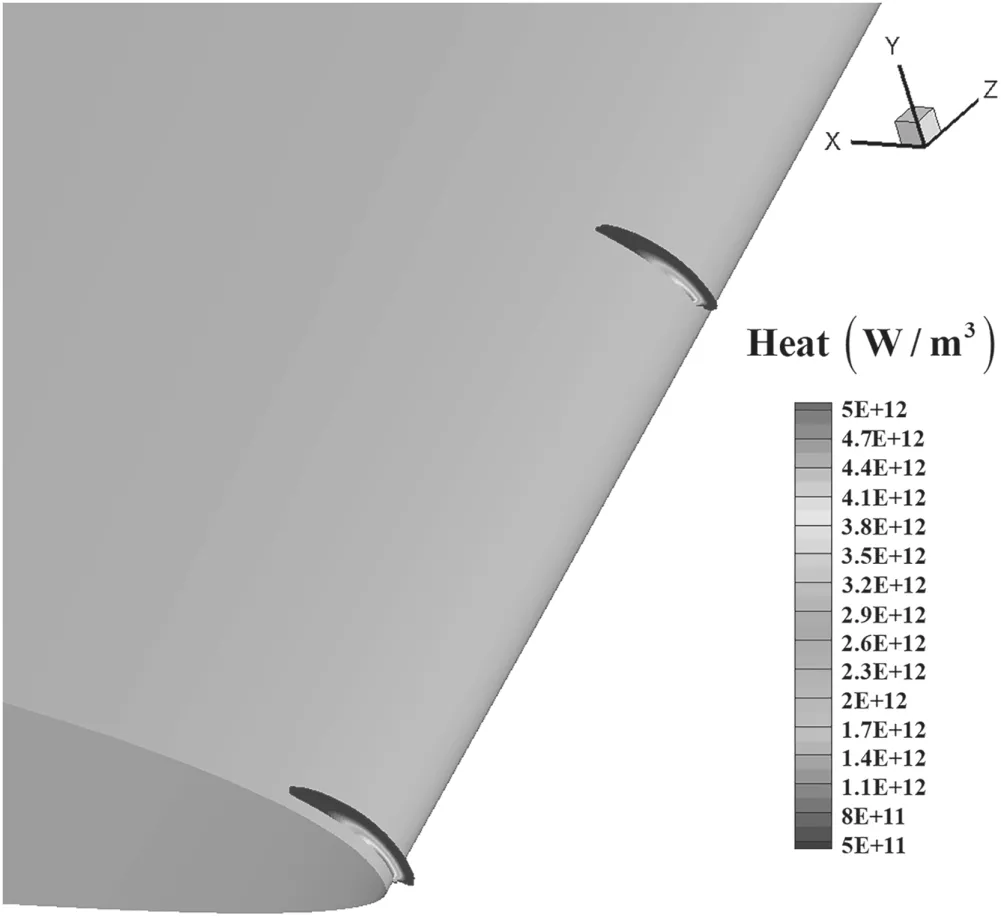
Figure 8.The spatial distribution of the heat source on the leading edge.
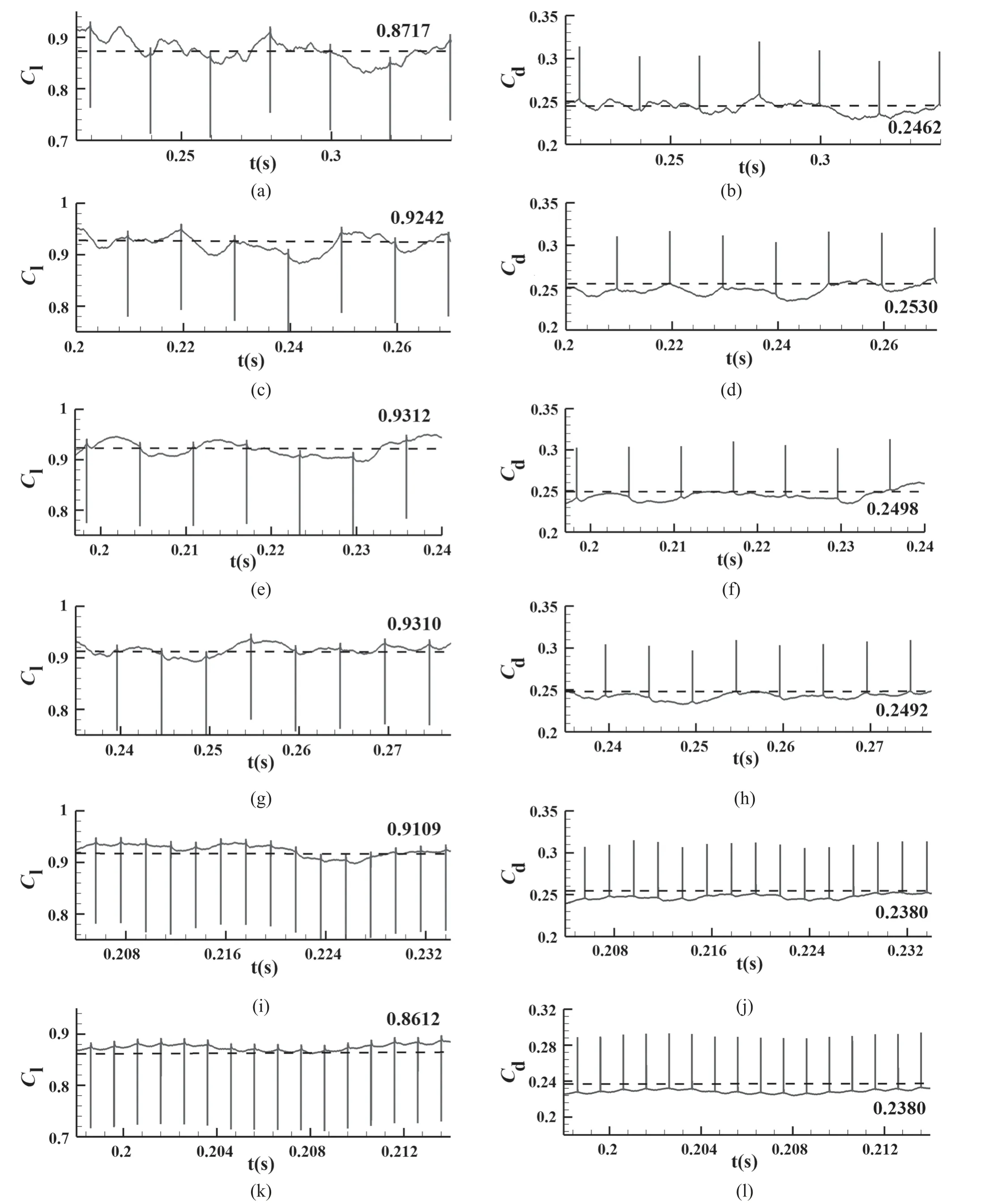
Figure 9.Aerodynamic coefficients under different actuation frequencies when the angle of attack is 18°,lift coefficient of 50 Hz(a),drag coefficient of 50 Hz(b),lift coefficient of 100 Hz(c),drag coefficient of 100 Hz(d),lift coefficient of 160 Hz(e),drag coefficient of 160 Hz(f),lift coefficient of 200 Hz(g),drag coefficient of 200 Hz(h),lift coefficient of 500 Hz(i),drag coefficient of 500 Hz(j),lift coefficient of 1000 Hz(k),drag coefficient of 1000 Hz(l).
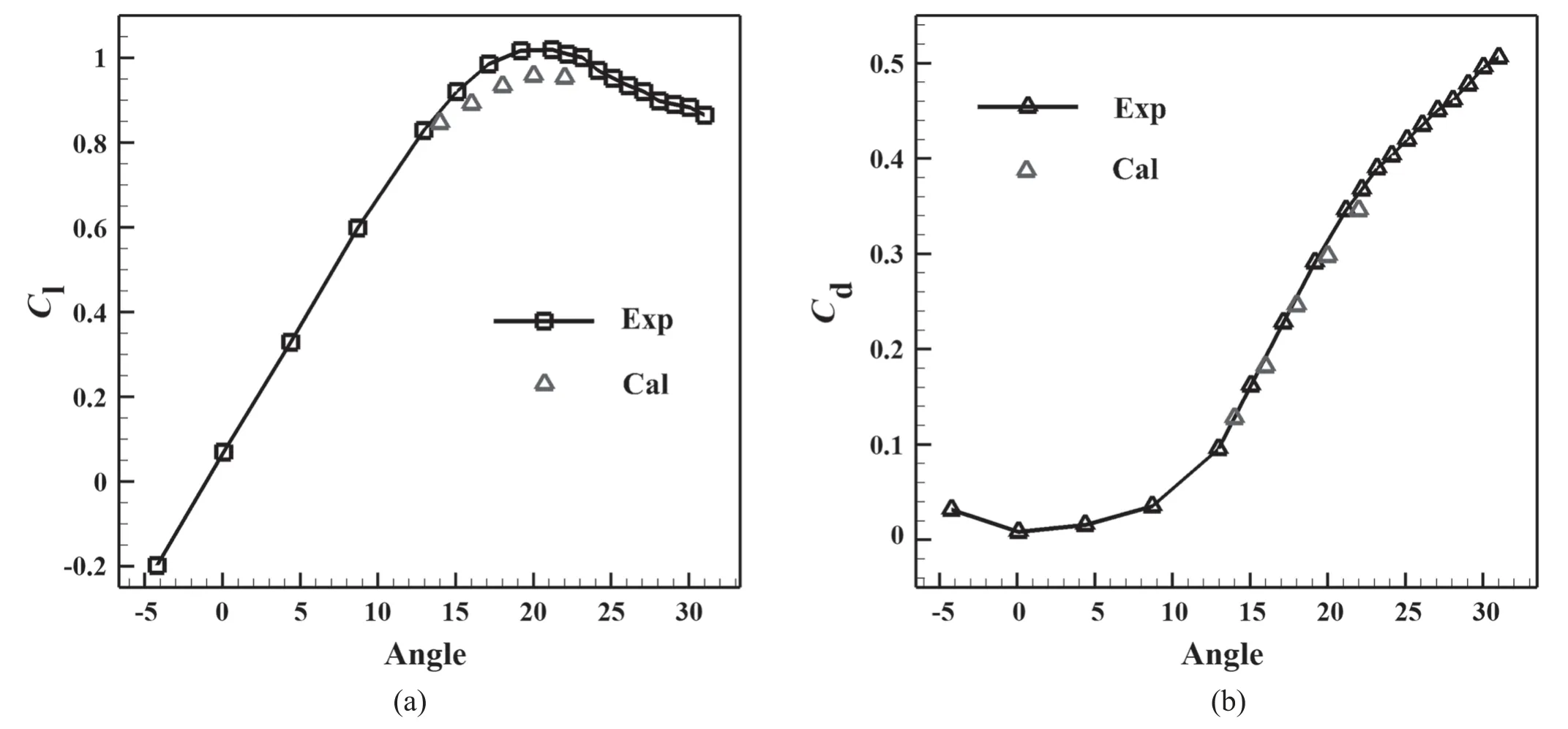
Figure 10.Contrast of aerodynamic force coefficients between the calculation and the experiment with the plasma actuation(f =100 Hz),lift coefficient(a),drag coefficient(b).
The scheme of ‘Fine grid+WALE’ is adopted to simulate other angles of attack states which are 14°,16°,20°,and 22°.The contrast of aerodynamic force coefficients between the calculation and the experiment without the plasma actuation is shown in figure 6.Results are in good agreement between the calculation and the experiment.
4.Numerical study
In the numerical study,the effect of NS-DBD plasma actuation on the flow is equivalent to a heat source model which can be depicted as follows[21]:
S(W m?3)is the maximum value of the heat source which is 5×1012in this simulation according to[21].a(m)andb(m)characterize the range of the heat source region in thexandydirections,respectively.In this simulation,ais 0.0015 m,bis 0.0005 m according to[21]andh(t)is a step function with a value of 0 or 1,which is used to control the actuation frequency.The determination process ofxandyin formula(4)is shown in figure 7.
Assuming a point N in the flow,so there is only one planeCperpendicular to the leading-edge AB of the wing and passing through the point N.Assuming that the intersection of planeCand AB is point M,if a point in the flow is on the planeC,the heat source must be calculated according to the coordinate system with point M as the origin.There must be a point O on the planeCand the wing surface closest to the point N,so the distance of NO isyand the distance of MO isxin formula(3).The spatial distribution of the heat source on the leading-edge is shown in figure 8.The action time of the heat source in each actuation cycle is 300 ns(half maximum width of the voltage waveform in figure 3).If the actuation frequency is 100 Hz,the actuation cycle is 0.01 s,so for most of the time in a cycle,there is no heat source.In order to save computation,the variable time step method which can change from 10 to 1000 ns is adopted.
In order to study the influent of the actuation frequency on flow separation control,six different actuation frequencies which are 50 Hz,100 Hz,160 Hz,200 Hz,500 Hz,and 1000 Hz are selected.Among these,when the actuation frequency is 160 Hz and taking the average aerodynamic chord length of the wing as the reference length,F+equals 1.In the numerical simulation,the energy of each discharge cycle is same,so the energy with an actuation frequency of 500 Hz is 10 times that with an actuation frequency of 50 Hz.
Aerodynamic coefficients under different actuation frequencies when the angle of attack is 18° are shown in figure 9.The value indicated by dotted line is time-averaged.When the plasma heat source begins to act,the lift coefficient will decrease sharply and the drag coefficient will decrease sharply owing to the high-temperature and high-pressure region on the leading-edge.When the actuation frequency is from 100 to 200 Hz(comparing with the base condition,the lift increase is 10.55%(100 Hz),11.39%(160 Hz),11.36%(200 Hz),respectively),a good effect on lift increasing can be obtained and when the actuation frequency is 500 Hz(the lift increasing is 8.96%),the control effect is also not bad.But when the actuation frequencies are 50 Hz(the lift increasing is 4.27%)and 1000 Hz(the lift increasing is 3.01%),it gets worse.Therefore,it is not that the higher the actuation frequency,the greater the energy,and the better the control effect.The fluctuation of aerodynamic coefficients gets smaller when the actuation frequency gets higher.This suggests that the higher the energy,the stronger the influence of plasma actuation on the flow.
The contrast of aerodynamic force coefficients between the calculation(14°,16°,18°,20°,22°)and the experiment with the plasma actuation frequency of 100 Hz is shown in figure 10.Because the plasma heat model is different from the actual discharge,the aerodynamic coefficients,especially the lift coefficient,have some differences from the experimental results,but the change tendency is consistent.The contrast of aerodynamic force coefficients between the experiment and the calculation when the plasma actuation frequency is 100 Hz and the angle of attack is 18° is shown in table 2.
Figure 11 shows the evolution of plasma-induced vortex structures when the actuation frequency is 100 Hz and the angle of attack is 18°,which are phase-averaged over the cycles in figure 9(c).The plasma-induced vortexes roll the high-speed fluid outside the boundary layer into the boundary layer so that the flow is reattached and the lift is increased.As the plasma-induced vortex moves downstream,the intensity of the induced vortex first increases and then decreases,and when it is at the 3T/4,the induced vortex intensity is already very low and when it is at the 4T/4,the induced vortex disappears above the wing.
Figure 12 shows the condition when the actuation frequency is 200 Hz and the plasma-induced vortex structures are phase-averaged over the cycles in figure 9(g).Because the condition in which the actuation frequency is 160 Hz is similar,it is not shown.During the whole period of actuation,the plasma-induced vortex structures are always above the wing,so it always has an effect on lift increasing.

Table 2.Contrast of aerodynamic force coefficients between the experiment and the simulation when the plasma actuation frequency is 100 Hz and the angle of attack is 18°.
Figures 13 and 14 show the condition when the actuation frequency is 500 Hz and 1000 Hz,respectively,and the plasma-induced vortex structures are phase-averaged over the cycles in figures 9(i)and(k),respectively.Obviously,on one hand,the plasma-induced vortex structures are not fully developed during an actuation period,especially for the condition of 1000 Hz.This is the main reason why the control effect gets worse.On the other hand,the vortex structures above the wing become more regular own to the higher frequency and larger energy of plasma actuation,especially for the condition of 1000 Hz.This is the main reason why the fluctuation of aerodynamic coefficients gets smaller.
Figure 15 shows the condition when the actuation frequency is 50 Hz and the plasma-induced vortex structures are phase-averaged over the cycles in figure 9(a).When they are at 2T/4,3T/4,and 4T/4,the plasma-induced vortex structures disappear above the wing and have no effect on lift increasing.This is the main reason why the control effect gets worse.
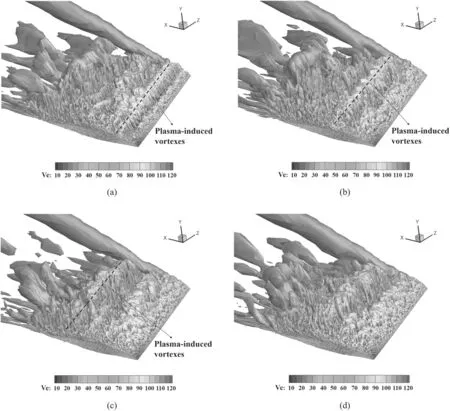
Figure 11.Evolution of plasma-induced vortex structures when the actuation frequency is 100 Hz and the angle of attack is 18°(Q=10 000),1T/4(a),2T/4(b),3T/4(c),4T/4(d).

Figure 12.Evolution of plasma-induced vortex structures when the actuation frequency is 200 Hz and the angle of attack is 18°(Q=10 000),1T/4(a),2T/4(b),3T/4(c),4T/4(d).
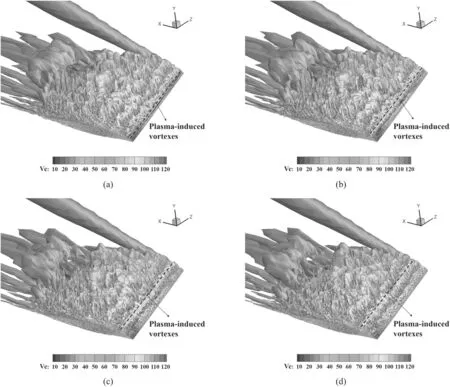
Figure 13.Evolution of plasma-induced vortex structures when the actuation frequency is 500 Hz and the angle of attack is 18°(Q=10 000),1T/4(a),2T/4(b),3T/4(c),4T/4(d).
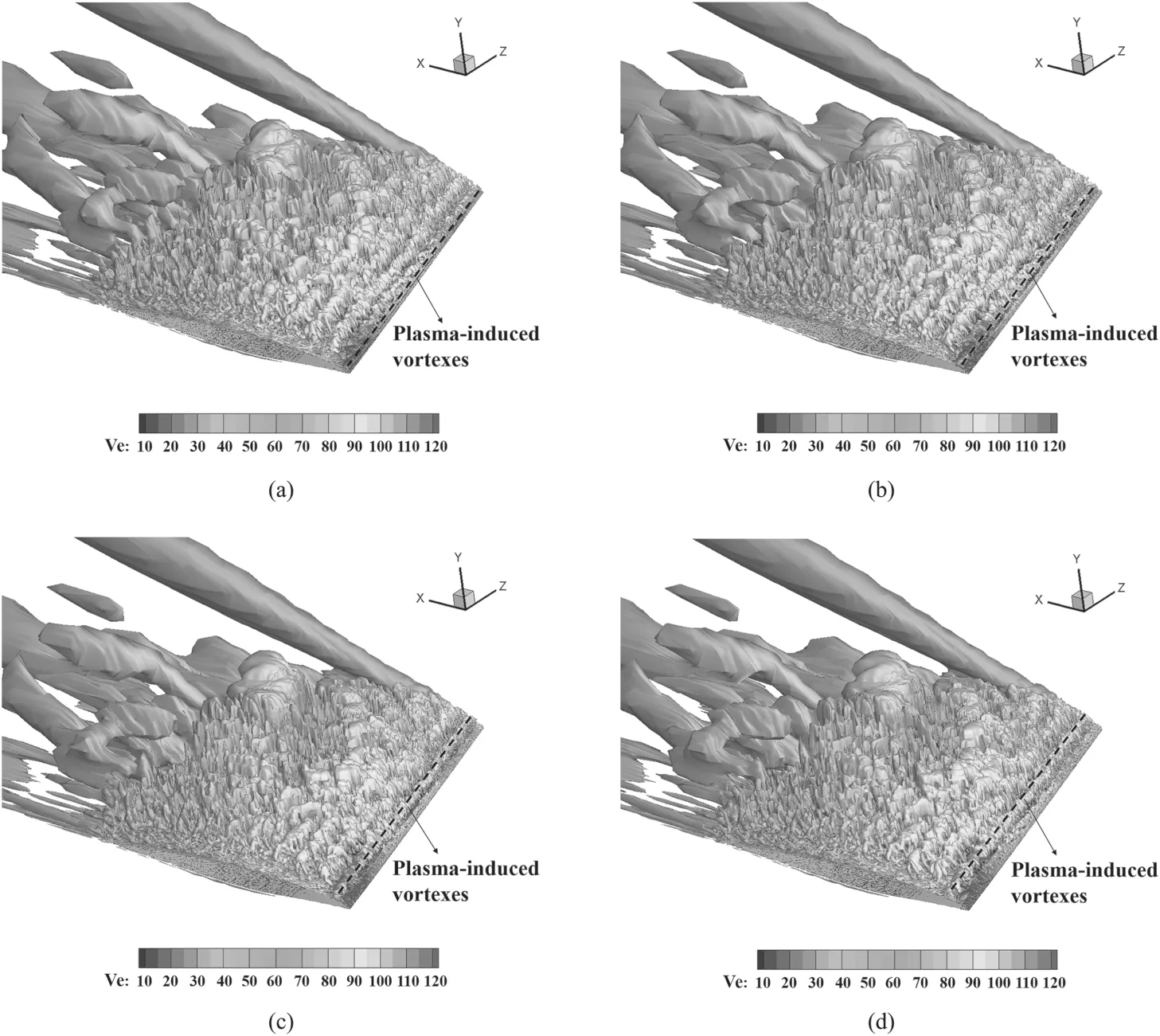
Figure 14.Evolution of plasma-induced vortex structures when the actuation frequency is 1000 Hz and the angle of attack is 18°(Q=10 000),1T/4(a),2T/4(b),3T/4(c),4T/4(d).
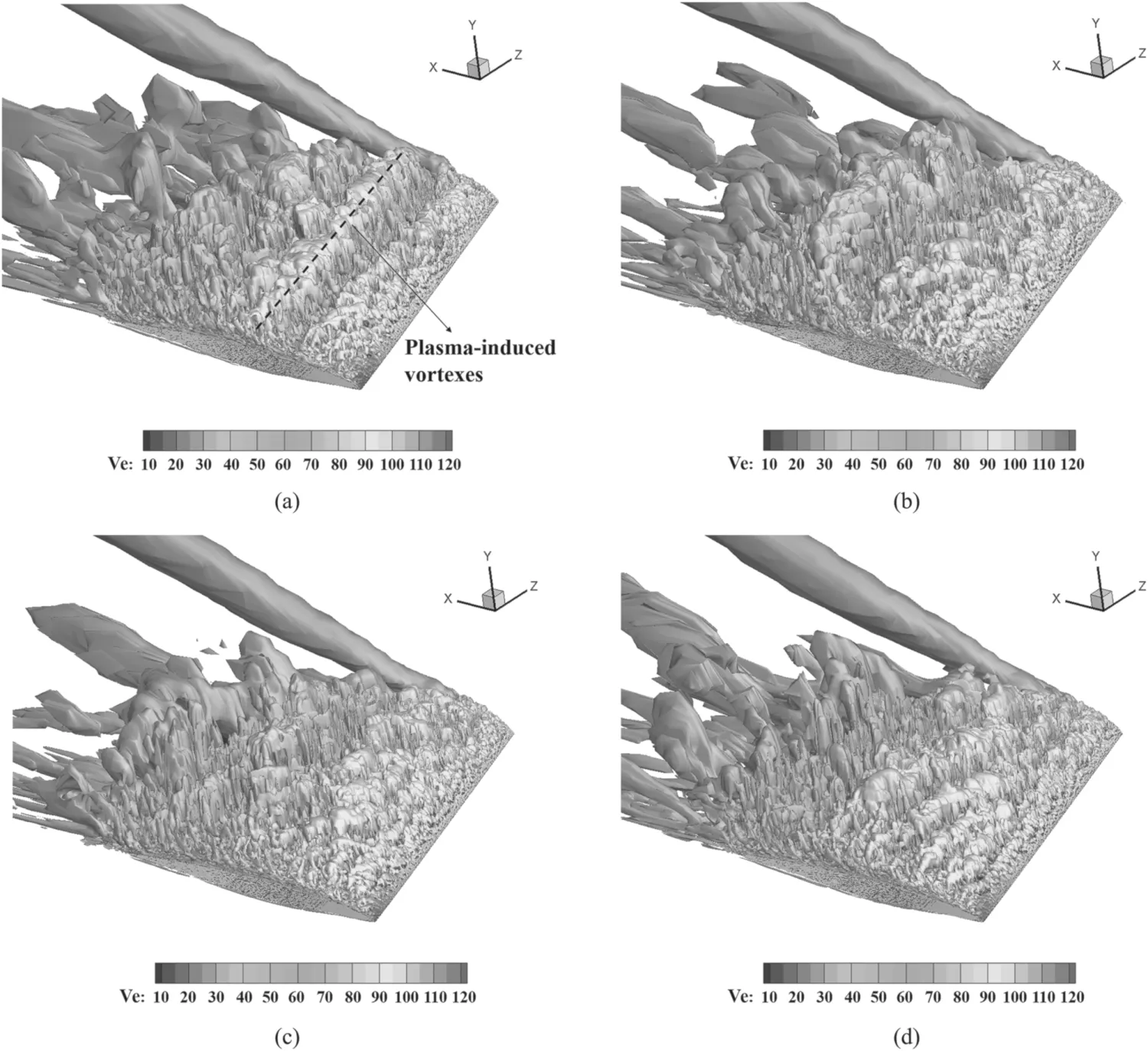
Figure 15.Evolution of plasma-induced vortex structures when the actuation frequency is 50 Hz and the angle of attack is 18°(Q=10 000),1T/4(a),2T/4(b),3T/4(c),4T/4(d).
5.Conclusions
In this work,numerical studies on plasma separation control of a swept wing with different actuation frequencies which are 50 Hz,100 Hz,160 Hz,200 Hz,500 Hz,and 1000 Hz,respectively are conducted,and experiment studies in which the actuation voltage is 8 kV and the actuation frequency is 100 Hz are conducted to validate the numerical method.Some conclusions can be drawn as follows:
(1)The mechanism of NS-DBD plasma flow separation control is mainly through the interaction between the plasma-induced vortexes which are closely related to the actuation frequency and the separated flow.If the actuation frequency is too low,the plasma-induced vortexes will disappear in a period within an actuation cycle;if the actuation frequency is too high,the plasmainduced vortex cannot develop completely,resulting in a weak vortex intensity.
(2)The higher the actuation frequency,the stronger the influence of plasma actuation on the flow,the more regular the vortex structures above the wing and the smaller the fluctuation of aerodynamic coefficients.
(3)For the flow separation control over an airfoil,there is an optimal actuation frequency which meetsF+=1to make the control effect best.For the flow separation control over a swept wing,there is a range of the actuation frequency which includes the frequency calculated by the average aerodynamic chord length to make the control effect good.
Acknowledgments
This research was supported by the National Science and Technology Major Project(No.J2019-II-0014-0035),Academician Workstation Foundation of the Green Aerotechnics Research Institute of Chonging Jiaotong University(No.GATRI2020C06003).
 Plasma Science and Technology2023年1期
Plasma Science and Technology2023年1期
- Plasma Science and Technology的其它文章
- Quasi-coherent mode in core plasma of SUNIST spherical tokamak
- High-resolution x-ray monochromatic imaging for laser plasma diagnostics based on toroidal crystal
- Numerical study of viscosity and heat flux role in heavy species dynamics in Hall thruster discharge
- Development of miniaturized SAF-LIBS with high repetition rate acousto-optic gating for quantitative analysis
- A study of the influence of different grid structures on plasma characteristics in the discharge chamber of an ion thruster
- Focused electron beam transport through a long narrow metal tube at elevated pressures in the forevacuum range
